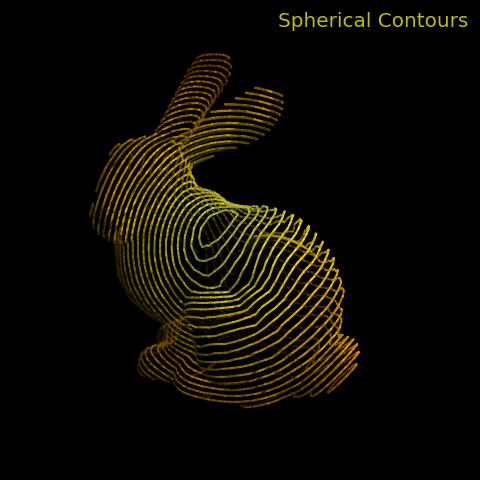Bunny Contours¶

Contours may be constructed from any surface object. These contours are from the surface object shown in the Stanford Bunny example.
import matplotlib.pyplot as plt
import s3dlib.surface as s3d
# Contours on a general surface object.
# 1. Stanford Bunny Obj datafile ................................
bsurf = s3d.get_surfgeom_from_obj("data/bunny.obj", color='k', cmap='Wistia')
# note: the bsurf-object native coordinates are Cartesian..(xyz)
radial_distance = lambda xyz : s3d.SphericalSurface.coor_convert(xyz)[0]
# 2. Setup surface ................................................
# center the object for cylindrical and spherical contours.
sc = [ -(bsurf.bounds['xlim'][1]+bsurf.bounds['xlim'][0])/2 ,
-(bsurf.bounds['xlim'][1]+bsurf.bounds['xlim'][0])/2 ,
-(bsurf.bounds['zlim'][1]+bsurf.bounds['zlim'][0])/2 ]
bsurf.transform(translate=sc)
bsurf.map_cmap_from_op( radial_distance ).shade() # effectively, shade contours.
contours = bsurf.contourLineSet(30,coor='s') # contour color taken from surface.
# 3. Construct figure, add surface, plot ..........................
fig = plt.figure(figsize=plt.figaspect(1), facecolor='k')
fig.text(0.975,0.975,'Spherical Contours', ha='right', va='top',
color='y' , fontsize='x-large')
ax = plt.axes(projection='3d', aspect='equal', facecolor='k')
ax.set_axis_off()
s3d.auto_scale(ax,bsurf,uscale=.9)
ax.add_collection3d(contours.fade())
fig.tight_layout(pad=0)
plt.show()
